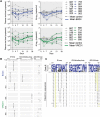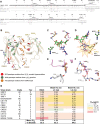A naturally arising broad and potent CD4-binding site antibody with low somatic mutation
- PMID: 35960796
- PMCID: PMC9374330
- DOI: 10.1126/sciadv.abp8155
A naturally arising broad and potent CD4-binding site antibody with low somatic mutation
Abstract
The induction of broadly neutralizing antibodies (bNAbs) is a potential strategy for a vaccine against HIV-1. However, most bNAbs exhibit features such as unusually high somatic hypermutation, including insertions and deletions, which make their induction challenging. VRC01-class bNAbs not only exhibit extraordinary breadth and potency but also rank among the most highly somatically mutated bNAbs. Here, we describe a VRC01-class antibody isolated from a viremic controller, BG24, that is much less mutated than most relatives of its class while achieving comparable breadth and potency. A 3.8-Å x-ray crystal structure of a BG24-BG505 Env trimer complex revealed conserved contacts at the gp120 interface characteristic of the VRC01-class Abs, despite lacking common CDR3 sequence motifs. The existence of moderately mutated CD4-binding site (CD4bs) bNAbs such as BG24 provides a simpler blueprint for CD4bs antibody induction by a vaccine, raising the prospect that such an induction might be feasible with a germline-targeting approach.
Figures






References
Grants and funding
LinkOut - more resources
Full Text Sources
Molecular Biology Databases
Research Materials

